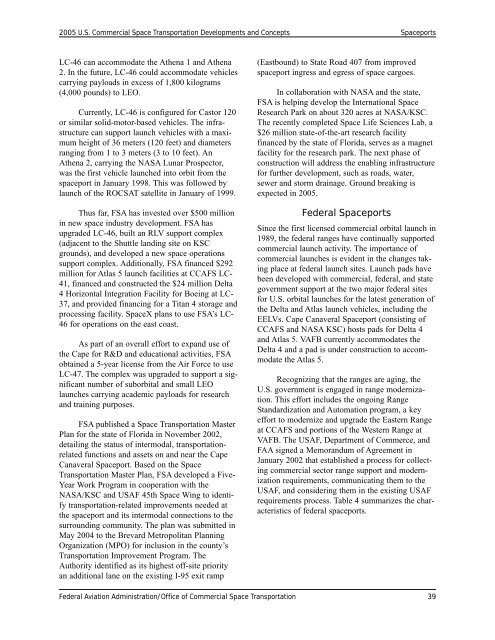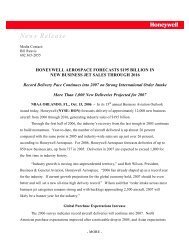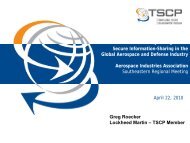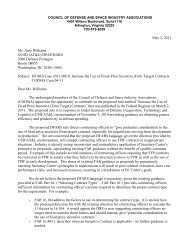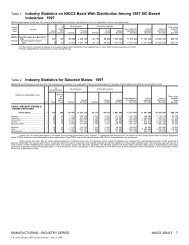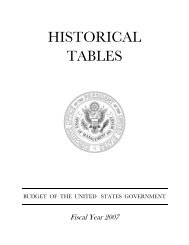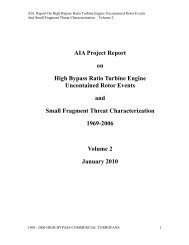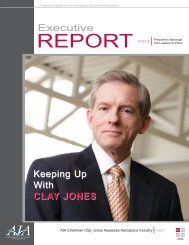Untitled - Aerospace Industries Association
Untitled - Aerospace Industries Association
Untitled - Aerospace Industries Association
You also want an ePaper? Increase the reach of your titles
YUMPU automatically turns print PDFs into web optimized ePapers that Google loves.
2005 U.S. Commercial Space Transportation Developments and Concepts SpaceportsLC-46 can accommodate the Athena 1 and Athena2. In the future, LC-46 could accommodate vehiclescarrying payloads in excess of 1,800 kilograms(4,000 pounds) to LEO.Currently, LC-46 is configured for Castor 120or similar solid-motor-based vehicles. The infrastructurecan support launch vehicles with a maximumheight of 36 meters (120 feet) and diametersranging from 1 to 3 meters (3 to 10 feet). AnAthena 2, carrying the NASA Lunar Prospector,was the first vehicle launched into orbit from thespaceport in January 1998. This was followed bylaunch of the ROCSAT satellite in January of 1999.Thus far, FSA has invested over $500 millionin new space industry development. FSA hasupgraded LC-46, built an RLV support complex(adjacent to the Shuttle landing site on KSCgrounds), and developed a new space operationssupport complex. Additionally, FSA financed $292million for Atlas 5 launch facilities at CCAFS LC-41, financed and constructed the $24 million Delta4 Horizontal Integration Facility for Boeing at LC-37, and provided financing for a Titan 4 storage andprocessing facility. SpaceX plans to use FSA’s LC-46 for operations on the east coast.As part of an overall effort to expand use ofthe Cape for R&D and educational activities, FSAobtained a 5-year license from the Air Force to useLC-47. The complex was upgraded to support a significantnumber of suborbital and small LEOlaunches carrying academic payloads for researchand training purposes.FSA published a Space Transportation MasterPlan for the state of Florida in November 2002,detailing the status of intermodal, transportationrelatedfunctions and assets on and near the CapeCanaveral Spaceport. Based on the SpaceTransportation Master Plan, FSA developed a Five-Year Work Program in cooperation with theNASA/KSC and USAF 45th Space Wing to identifytransportation-related improvements needed atthe spaceport and its intermodal connections to thesurrounding community. The plan was submitted inMay 2004 to the Brevard Metropolitan PlanningOrganization (MPO) for inclusion in the county’sTransportation Improvement Program. TheAuthority identified as its highest off-site priorityan additional lane on the existing I-95 exit ramp(Eastbound) to State Road 407 from improvedspaceport ingress and egress of space cargoes.In collaboration with NASA and the state,FSA is helping develop the International SpaceResearch Park on about 320 acres at NASA/KSC.The recently completed Space Life Sciences Lab, a$26 million state-of-the-art research facilityfinanced by the state of Florida, serves as a magnetfacility for the research park. The next phase ofconstruction will address the enabling infrastructurefor further development, such as roads, water,sewer and storm drainage. Ground breaking isexpected in 2005.Federal SpaceportsSince the first licensed commercial orbital launch in1989, the federal ranges have continually supportedcommercial launch activity. The importance ofcommercial launches is evident in the changes takingplace at federal launch sites. Launch pads havebeen developed with commercial, federal, and stategovernment support at the two major federal sitesfor U.S. orbital launches for the latest generation ofthe Delta and Atlas launch vehicles, including theEELVs. Cape Canaveral Spaceport (consisting ofCCAFS and NASA KSC) hosts pads for Delta 4and Atlas 5. VAFB currently accommodates theDelta 4 and a pad is under construction to accommodatethe Atlas 5.Recognizing that the ranges are aging, theU.S. government is engaged in range modernization.This effort includes the ongoing RangeStandardization and Automation program, a keyeffort to modernize and upgrade the Eastern Rangeat CCAFS and portions of the Western Range atVAFB. The USAF, Department of Commerce, andFAA signed a Memorandum of Agreement inJanuary 2002 that established a process for collectingcommercial sector range support and modernizationrequirements, communicating them to theUSAF, and considering them in the existing USAFrequirements process. Table 4 summarizes the characteristicsof federal spaceports.Federal Aviation Administration/Office of Commercial Space Transportation 39


